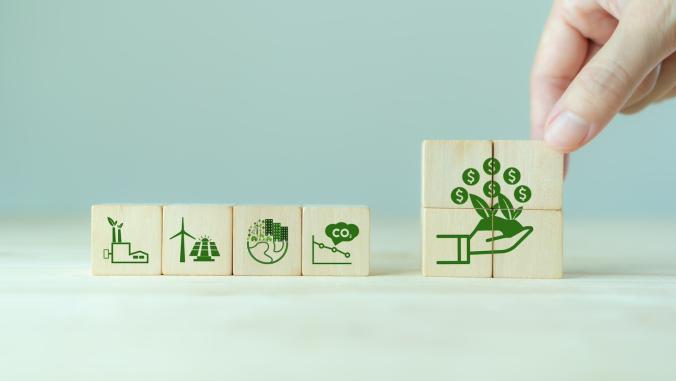Anheuser-Busch, Kimberly-Clark amp up wind power commitments
Influential manufacturers are balancing on-site investments with big power purchase agreements.

For a gut check on the complexity — and the opportunity — for companies interested in buying renewable energy, ponder this: Brewer Anheuser-Busch evaluated 75 projects and held talks with 15 possible partners before signing its massive power purchase agreement disclosed last week for an Oklahoma wind farm owned by Enel Green Power.
The deal will cover about 50 percent of the power used by Anheuser-Busch's operations across North America, according to top executives from both companies.
Meanwhile, personal care products company Kimberly-Clark has orchestrated arrangements with the developers of two projects, one in Oklahoma and one in Texas, that together represent about one-third of electricity used by its North American manufacturing operations for brands such as Kleenex and Huggies. The aggregate amount across the farms is 245 megawatts in capacity, or about 1 million megawatt-hours.
The scale of these commitments underscores just how serious big-name consumer products companies remain about reducing their greenhouse gas (GHG) emissions impact, despite the U.S. decision to withdraw support for the Paris Agreement. If anything, some are trying to move faster.
In the case of Kimberly-Clark, for example, the new deals for the Rock Falls Wind in Oklahoma (EDF Renewables) and Santa Rita Wind Energy Center in Texas (Invenergy) should help the company reach its GHG emissions reduction goal four years earlier than anticipated, according to Lisa Morden, the company's global head of sustainability. The projects are expected to be operational in late 2017 and the second quarter of 2018, respectively.
"The two renewable energy projects, combined with a number of other energy initiatives across the company, put Kimberly-Clark on track to deliver significant multimillion-dollar cost savings from energy and climate projects by 2022," Morden said. "It's a powerful demonstration of sustainability initiatives having both great environmental and business benefits."
Brewing up more wind power
Anheuser-Busch's deal is tied to the beermaker's Belgian parent company Anheuser-Busch InBev's aspiration to source 100 percent of the power needed to run its operations, about 6 terrawatts of electricity worldwide, by 2025. When it declared its goal, it was about 7 percent of the way there. With this latest project, it's closer to 25 percent globally.
The contract disclosed last week covers 152.5 megawatts of capacity from the Thunder Ranch project in Garfield, Kay and Noble counties in Oklahoma. That's essentially half of the planned total output for the facility. It represents about 610 gigawatt-hours of clean energy annually — enough electricity to brew up 20 billion 12-ounce servings of its brands such as Michelob.
Prior to the new virtual PPA, just 2 percent of Anheuser-Busch's North American power supply was covered by renewables, largely as the result of on-site investments in solar, biogas, wind and other alternative technologies at sites brewing its brands, according to Anheuser-Busch president and CEO Joao Castro, who spoke during a briefing about the deal.
So this represents a huge leap forward to the 100 percent renewable goal trumpeted by the beermaker's Belgian parent company Anheuser-Busch InBev back in March when it joined the Climate Group's RE100 initiative. The company uses almost 6 terrawatts of electricity worldwide. When it declared its goal, it was about 7 percent of the way there. With this latest project, it's closer to 25 percent.
The company's aim is to source all of its purchase electricity from renewable sources by 2025, and Castro hinted that more deals are to come in the relatively near future. He described the strategy as the best path forward from an operational standpoint "all stakeholders" in the company. "We as a management team believe this is the right thing to do," Castro said.
Anheuser signed a smaller PPA earlier this year in Mexico, covering 490 gigawatt-hours annually from both solar and wind generating plants. That investment will increase the country's clean power capacity by more than 5 percent, when they start coming online in the first half of 2019.
"We have the potential to make a big impact much sooner," Castro said.
The company didn't disclose the terms of the deal, such as length of the contract or the price per megawatt, but Enel Green Power's overall investment in the project was previously pegged at $435 million. The company, a subsidiary of Italian power company Enel, managers about 39 gigawatts of solar, wind, geothermal, biomass and hydropower projects around the world.
A small portion of the beermaker's operations will be served directly by the power generated by the Thunder Ranch wind farm, because it employs 700 people in Oklahoma. But as is the case with many VPPAs, the rest will be added to the local grid in the region where other customers will be able to use it, said Katja Zastrow, vice president of corporate social responsibility — Better World, Anheuser-Busch. That means the company will still need to contract for other power sources delivered physically to sites across the U.S. Anheuser-Busch will keep and retire the renewable energy credits associated with the PPA.
Oklahoma was the third largest state for wind capacity at the beginning of 2017, with about 6,645 megawatts. The market dynamics shifted there last spring when Gov. Mary Fallin approved a bill ending a major tax incentive for plants put into service after July, citing the state's budget shortfalls. That was three years earlier than anticipated.





